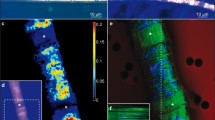Summary
Ionic calcium concentration was measured in the gonidial zone of fresh coralloid roots by means of calcium microelectrodes. It was 10−6 M in the apical segments of coralloid roots and increased to 10−5 M in the gonidial zones of median and basal segments. Loosely membrane-bound calcium was evidenced by using chlorotetracycline (CTC) or ethylene glycol-bis-(β-aminoethyl ether)-N,N,N′,N′-tetraacetic acid (EGTA) and CTC, in cell walls of columnar cells ofCycas and in the cytoplasm of cyanobiont. Sub-cellular localization of calcium was obtained by electron spectroscopic imaging (ESI) and electron energy loss spectroscopy (EELS) analyses applied at transmission electron microscopy on thin, unstained sections of gonidial zone of coralloid roots. By means of these techniques, bound-calcium was detected inside the mucilage of apical and median segments whereas, in the basal segments, it was completely absent. In the heterocysts of apical segments of coralloid, calcium was localized on the envelope, cell walls, thylakoids and cyanophycin granules. In the gonidial zone of the basal segments, dead or degenerating heterocysts completely lacked calcium. Therefore, the high ionic calcium amounts detected in the gonidial zone of median and basal segments could represent a minor calcium uptake by the cells or release by lysed ones. The decreases in nitrogenase activity recorded in the median and basal segments of the coralloid roots paralleled the decrease in calcium amount in heterocyst envelope.
Similar content being viewed by others
Abbreviations
- CTC:
-
chlorotetracycline
- EGTA:
-
ethylene glycol-bis-(β-aminoethyl ether)-N,N,N′,N′-tetraacetic acid
- ESI:
-
electron spectroscopic imaging
- EELS:
-
electron energy loss spectroscopy
References
Becker DW, Brand JJ (1985)Anacystis nidulans demonstrates a photosystem II cation requirement satisfied only by Ca2+ or Na+. Plant Physiol 79: 552–558
Canini A, Grilli Caiola M (1993) Characterization of gonidial zone ofCycas revoluta coralloid roots by means of microelectrodes. FEMS Microbiol Lett 109: 146–153
— —, Bertoccchi P, Lavagnini MG, Mascini M (1992) Ion determinations withAzolla leaf cavities by microelectrodes. Sensors Actuators B 7: 431–435
—, Albertano P, Grilli Caiola M (1993) Sub-cellular localization of calcium inAzolla-Anabaena symbiosis by chlorotetracycline, ESI and EELS. Bot Acta 106: 146–153
Chang CF, Shuman H, Somlyo A (1987) Electron probe analysis, X-ray mapping, and electron energy-loss spectroscopy of calcium, magnesium, and monovalent ions in log-phase and in dividingEscherichia coli B cells. J Bacteriol 167: 935–939
Grilli M, Trabucchi B (1964) Osservazioni sulle strutture e le infrastrutture delle cellule dei tubercoli radicali diCycas revoluta. Ann Facoltà Agraria III: 467–481
Grilli Caiola M (1980) On the phycobionts of the cycad coralloid roots. New Phytol 85: 537–544
—, Canini A (1993) Structure and physiology of cycad coralloid roots. Giorn Bot Ital 127: 428–433
Hamadi AF, Gallon JR (1981) Calcium ions, oxygen and acetylene reduction (nitrogen fixation) in the unicellular cyanobacteriumGloeocapsa sp. 1430/3. J Gen Microbiol 125: 391–398
Kerson GW, Miernyk JA, Budd K (1984) Evidence for the occurrence of, and possible physiological role for, cyanobacterial calmodulin. Plant Physiol 75: 222–224
Lindblad P, Bergman B, von Hofsten A, Hällbom L, Nylund JE (1985) The cyanobacterium-Zamia symbiosis: an ultrastructural study. New Phytol 101: 707–716
—, Atkins CA, Pate JS (1991) N2-fixation by freshly isolatedNostoc from coralloid roots of the cycadMacrozamia riedlei (Fisch es Gaud) Gardn. Plant Physiol 95: 753–759
Obukowicz M, Schaller M, Kennedy GS (1981) Ultrastructure and phenolic histochemistry of theCycas revoluta-Anabaena symbiosis. New Phytol 87: 751–759
Onek LA, Smith RJ (1992) Calmodulin and calcium mediated regulation in prokaryotes. J Gen Microbiol 138: 1039–1049
Rodriguez H, Rivas J, Guerrero MG, Losada M (1990) Ca2+ requirement for aerobic nitrogen fixation by heterocystous bluegreen algae. Plant Physiol 92: 886–890
Smith RJ, Hobson S, Ellis IR (1987) Evidence for calcium-mediated regulation of heterocyst frequency and nitrogenase activity inNostoc 6720. New Phytol 105: 531–542
Tretyn A, Kopcewicz J (1988) Calcium localization in oat aleurone cells using chlorotetracycline and X-ray microanalysis. Planta 175: 237–240
Wolk CP (1982) Heterocysts. In: Carr NG, Whitton BA (eds) The biology of cyanobacteria. Blackwell, London, pp 359–386
Author information
Authors and Affiliations
Rights and permissions
About this article
Cite this article
Canini, A., Brandizzi, F. & Grilli Caiola, M. Localization of calcium in the cyanobiont and gonidial zone ofCycas revoluta Thunb. by microelectrodes, chlorotetracycline, electron spectroscopic imaging and electron energy loss spectroscopy. Protoplasma 179, 151–157 (1994). https://doi.org/10.1007/BF01403953
Received:
Accepted:
Issue Date:
DOI: https://doi.org/10.1007/BF01403953




